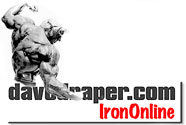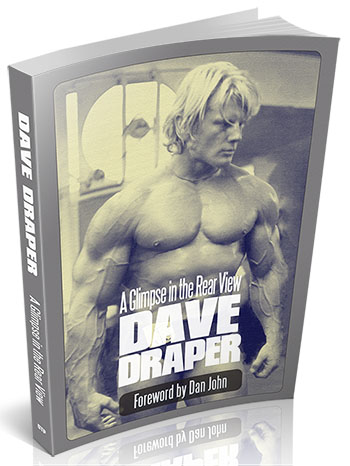HIT and Heavy Duty Training
A
Brief Primer on High Intensity Training
Page 2 of 4
Written By Steve Wedan
Click here if you missed page 1
Another point: Work varies largely by the range of motion a person moves a resistant bar. That's why, if I were forced to choose only one pressing motion, I would choose an overhead press. The stroke takes place over a greater distance, and thus the work is greater, even if the resistance is lower than the poundage I could handle lying on a bench (this assumes I haven't been doing overhead pressing exclusively for years; because of a lack of proper pectoral conditioning, in this case, benching could easily outwork pressing).
Sheer weight means a lot in weight training. But range of motion means at least as much. This is one of two reasons why the squat and the deadlift are the two best exercises for overall growth: First, each involves most of the entire muscle mass of one's body; and two, the exercise stroke is much farther than any press, any pull, and certainly more than the heaviest calf raise, for example. Arnold was famous for claiming in the early 1970s that he whipped his calves into shape by doing calf raises with a thousand pounds. Assuming the claim is true (who really knows, since articles that contain bylines of the champs almost never are written by them. And Joe Weider's staff writers might have just been trying to sell more magazines when the 1,000-pound calf raise claim was made), you can bet that the exercise didn't add much more muscle to his body than calf mass (and I doubt even that, since he went on to claim he lifted that much weight over many sets, every single day).
Doing squats, though, with several hundred pounds LESS weight DID add much, both because of the amount of overall muscle required to squat, and because moving weight over a greater resistance results in greater work. That, over whatever time it took to reach a sufficient inroad in his muscles to stimulate growth, is what determines how intense the set was.
Okay, so, intensity is the work one performs over time. And Arthur Jones took that concept to its logical extreme by saying one should seek to achieve maximum growth stimulus (a.k.a.," inroad") in one set by performing reps to absolute, utter failure. Doing that maximizes intensity by packing as much work as possible into as small a unit of time as possible, one set.
Now, back to the story.
Arthur grumbled for years about the intransigence of bodybuilders. The first time I met him and asked what I considered a challenging question regarding the exercise volume he recommended in an article published a couple years earlier, he replied with, "You're a bodybuilder, aren't you?" It was not meant as a compliment. His experience was that while many showed interest in what he insisted was the single rational approach to building muscles, few understood. Few, that is, understood well enough to continue following his concepts after finding out how hard it was to work out at that level of intensity.
The final straw came when Fred Hatfield, who in 1985 was working for one of the Weider magazines, visited him in Florida, was taught for days not only the old concepts, but all the new things Arthur had been discovering about training. Hatfield seemed excited about it and even accepting of it, then promptly went back to California and wrote an article that resembled an expose more than a report. If Arthur Jones can be surprised and hurt, that one event seemed to do both to a greater extent than anything else could have done in his professional life.
As a result of this and an accumulation of other indignities over the years, Arthur followed his growing interest in purely medical research and sold the Nautilus company. He recently wrote a series of articles in the new IronMan (you know, the magazine that once represented independence and dignity and a certain moral high road and then was sold in 1985, becoming one more expensive, skin-magazine/supplement-catalogue combination), espousing his ideas as they currently stand. In short, he says the trainee probably should train his body only twice a week, not three times, and that, to a certain degree, the fewer the exercises, the better. While always a devotee of high intensity training, his recommendations reveal a discernable evolution in the past thirty years.
It was left to Ellington Darden, originally known as Ell Darden when he was competing in regional and national (U.S.A.) bodybuilding events, to continue the tradition of setting up training experiments and publishing the results. I can't give you a hard number, but I would guess he's set up and overseen literally dozens of these studies, each lasting weeks. His books number in the dozens, and the past ten years have seen him focus more and more on free weights. Although it would be easy to assume he was simply following his market, those people out in the gyms training with free weights and shunning machines, he did tell me in private back in 1986 that you really can't improve on the barbell squat as a result-producing exercise. This was said back when the Nautilus Duo-Squat Machine was getting the big push, and he was still working for the company.
Whatever his motives, Darden has deeply influenced training since the mid-1970s when he wrote The Nautilus Book. His recommended training approach in brief consists of strict control of form and pace, in brief, intense workouts. Since the early 1990s, he has embraced a slow rep approach, mainly because his experiments with slow reps have created such astounding results, especially in trainees who seemed to have maxed out their genetics. Eddie Robinson was one champion bodybuilder who saw remarkable new growth training under Darden, and there were others. Darden also has espoused mini-cycles, as seen in his book, Big. In a six-week cycle, the trainee begins with three full-body workouts each week and ends with two per week. As we'll see, even this can be too much when going full-bore in HIT.
Darden got his clue about slow motion reps from Ken (originally known as, well, Ken; unlike others, he seems not to have needed to formalize his name as his influence grew!) Hutchins. Ken is another intellectually-enhanced man, an engineer type who originally worked at Jones's Nautilus headquarters. A New York fellow convinced Ken to try using slow reps in his research, because the guys at his gym who were trying it were getting real big and real strong. Eventually Ken used the slow rep protocol in a large population study of osteoporosis in elderly women, mainly because they got injured using regular speed reps.
The results of the study showed a general reversal of the bone disease, as well as growth of muscle tissue these women had never experienced in their lives. Ken then went on to formalize rep speed and to continue his studies. Armed with positive results, he tried unsuccessfully to convince his boss, Arthur Jones, to employ the slow rep-speed protocol, and the resultant conflict created a rift which caused Ken to go his own way. He now heads an organization that includes a certification program that entitles a person who completes it to become a trainer.
Click here to go to page three of the HIT primer
Steve
Wedan is an artist and writer. He also is a contributor
to the IOL Forum.
You can see and order his new print of Dave by clicking on this link.
Click here if you missed Steve's article on Arthur Jones and Casey Viator
Click here to catch up with Dr. Ken

